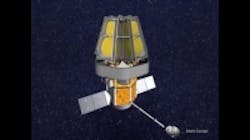DARPA building folding space telescope with lightweight membrane optics
With its Membrane Optical Imager for Real-Time Exploitation (MOIRE), the Defense Advanced Research Projects Agency (DARPA) is hoping to create a technology that would enable future high-resolution orbital telescopes to provide real-time video and images of the Earth from 22,000 miles above Earth.
Thus far, size and cost constraints have prevented the placement of large-scale imaging satellites into Geosynchronous Earth Orbit (GEO, or 22,000 miles above Earth), according to DARPA. With the MOIRE program, orbital telescopes would become much lighter, more transportable, and more cost-effective. The program is currently in its final phase, having recently demonstrated a ground-based prototype which incorporated several technologies, including new lightweight polymer membrane optics, which replace the traditional glass mirrors used in existing telescopes.
MOIRE has developed membrane optics that has nearly doubled the efficiency of existing technologies, from 30% to 55%, which enabled it to capture the first images ever using membrane optics. While glass optics operate at about 90% efficiency, the newly-developed membrane optics lighter weight (about one-seventh of the weight of a traditional system) enabled the creation of larger lenses that compensate for the difference in efficiencies.
In addition to the difference in size and weight, membrane optics also work differently than glass optics. While glass mirrors reflect light, MOIRE’s membrane optics diffract light. DARPA explains that the membrane is about the thickness of household plastic wrap, and each membrane serves as a Fresnel lens, as it is etched with circular concentric grooves like microscopically thin tree rings, with the grooves hundreds of microns across at the center down to only 4 µm at the outside edge. The diffractive pattern focuses light on a sensor that the satellite then translates into an image.
As a result, the successful deployment of membrane optics into GEO would have a significant impact, according to Lt. Col. Larry Gunn, DARPA program manager.
"Membrane optics could enable us to fit much larger, higher-resolution telescopes in smaller and lighter packages," he said in the press release. "In that respect, we’re ‘breaking the glass ceiling’ that traditional materials impose on optics design. We’re hoping our research could also help greatly reduce overall costs and enable more timely deployment using smaller, less expensive launch vehicles."
DARPA estimates that from GEO, a satellite using MOIRE optics could see approximately 40% of the Earth’s surface at once, and would be able to focus on a 10 km by 10 km area at 1-meter resolution, while providing real-time video at 1 fps.
View the press release.
Also check out:
DARPA Robotics Challenge trials to test robots in disaster response operations
NASA aircraft gathers data on Earth’s ecosystems
Cassini spacecraft image shows Earth, Saturn, Venus, and Mars all at once
Share your vision-related news by contacting James Carroll, Senior Web Editor, Vision Systems Design
To receive news like this in your inbox, click here.
Join our LinkedIn group | Like us on Facebook | Follow us on Twitter | Check us out on Google +
About the Author

James Carroll
Former VSD Editor James Carroll joined the team 2013. Carroll covered machine vision and imaging from numerous angles, including application stories, industry news, market updates, and new products. In addition to writing and editing articles, Carroll managed the Innovators Awards program and webcasts.
